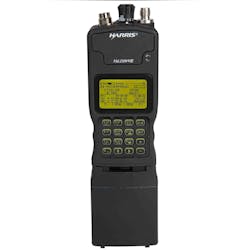Air Force chooses Harris to build HH-VDL video data link handheld radios for situational awareness
Officials of the Air Force Life Cycle Management Center at Wright-Patterson Air Force Base, Ohio, announced a $130 million contract to Harris on Friday to develop and build the Handheld Video Data Link (HH-VDL) radio.
The HH-VDL radio will help Air Force battlefield airmen exchange secure and unsecure full-motion video and annotated images with command authorities via a small, lightweight, ruggedized, and reliable transceiver.
Battlefield airmen will carry the HH-VDL system for long durations on limited battery power in a variety of difficult environmental and combat conditions. Battlefield airmen include combat air controllers, pararescuemen, special operations weather teams, and tactical air controllers.
Related: Harris to provide military Special Operations radios for sensitive and covert missions
Video data link capability improves intelligence, surveillance, and reconnaissance (ISR) that is essential to close air support, command and control (C2), air superiority, target identification, and situational awareness (SA), Air Force officials say.
The HH-VDL system must have Type 1 encryption capability through the use of National Security Agency (NSA) cryptocore modernization and government-approved encryption.
The system must be depot-level repairable, and interoperable with 466ER, Tactical, VNW, FM analog, DDL, STD-CDL and BE-CDL waveforms. It will support UHF, L-band, S-band, C-band, and KU-band, and support new S-band frequencies of 2025 to 2110 MHz. The HH-VDL radio will be water-resistant and ruggedized.
Air Force experts particularly are interested in evolutionary increases in capability, as well as reductions in size, weight, and power consumption (SWaP).
Related: General Dynamics to provide military mobile radios in $107.3 million contract
Harris already offers the RF-7800T-HH situational awareness video receiver (SAVR) lightweight, multiband radio for full-motion video and sensor data feeds from aircraft or unmanned aerial vehicles (UAVs).
This handheld radio is warfighters operating on foot, and also can be used for vehicular and tactical operations center applications. The Harris SAVR can be integrated with the Harris RF-3590 ruggedized tablet and Harris Falcon III radios to share video access throughout mission networks.
The SAVR includes an embedded GPS, and a software-defined architecture to keep pace with emerging digital data link standards through software upgrades.
On this contract Harris will do the work in Rochester, N.Y., and should be finished by April 2023. For more information contact Harris RF Communications online at www.harris.com, or the Air Force Life Cycle Management Center at www.wpafb.af.mil/aflcmc.
Ready to make a purchase? Search the Military & Aerospace Electronics Buyer's Guide for companies, new products, press releases, and videos
